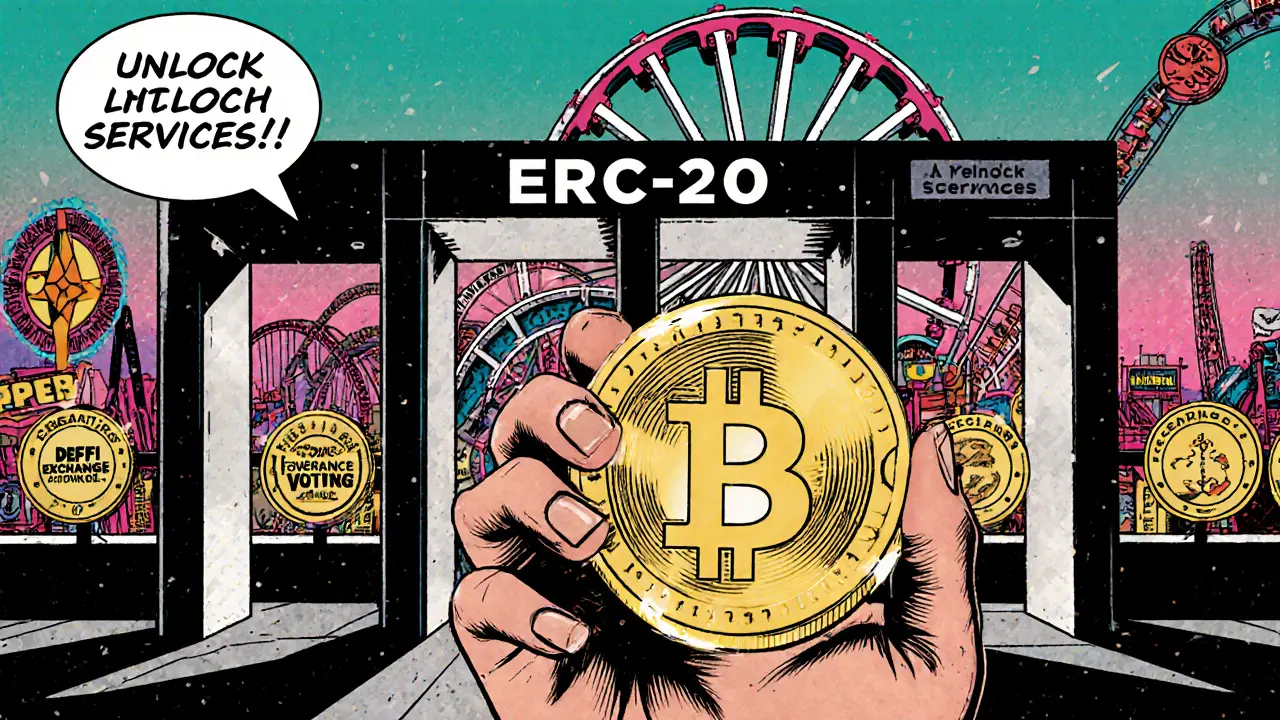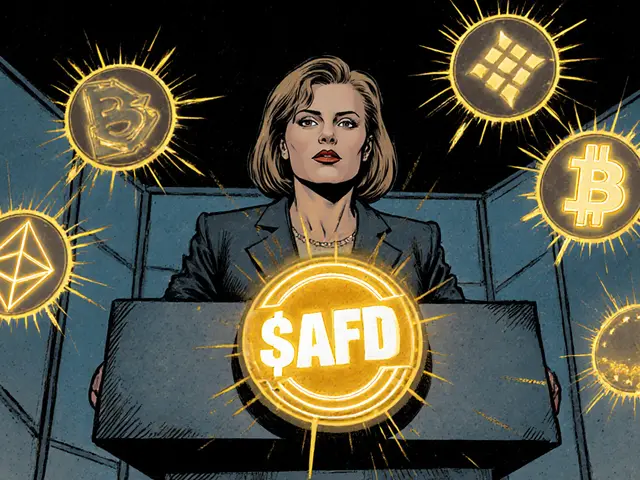
Key Takeaways
- Utility tokens grant access to a platform’s services; security tokens represent ownership or financial rights.
- Security tokens must pass the Howey Test and obey securities law, while utility tokens are largely unregulated.
- Technical standards differ: ERC‑20 for utilities, ERC‑1400/ST‑20 for securities with built‑in compliance.
- Security tokens show lower price volatility but face liquidity and accreditation barriers.
- Hybrid models are emerging, mixing utility features with regulated security functions.
When you hear the words "utility token" and "security token" in the same conversation, the reaction is often, "what's the real difference?" Both live on blockchains, both are digital assets, yet they sit on opposite sides of regulation, investor rights, and technical design. This guide cuts through the jargon, shows you the practical impact of each token type, and helps you decide which one fits your project or investment strategy.
Utility Token is a fungible digital asset that provides holders with access to a specific product or service within a blockchain platform, without conferring ownership or dividend rights. Think of it as a prepaid ticket to a theme park: you buy the token, then you can ride the rides (use the service) but you don’t own the park.
Security Token is a tokenized financial security that represents an ownership stake, debt, or other investment claim, and therefore falls under securities regulations. It’s more like a share certificate that entitles you to dividends and voting power.
Utility Tokens: Purpose and Typical Use Cases
Utility tokens exploded during the 2017‑2018 ICO boom, riding on Ethereum’s ERC‑20 standard (which still powers about 92% of utility offerings, according to Etherscan data from August 2023). The token’s main job is to act as a digital key:
- Access to a decentralized exchange’s reduced‑fee tier (e.g., IXS Token on IX Swap).
- Payment for cloud storage on Filecoin (FIL token).
- Governance voting on protocol upgrades (e.g., Uniswap’s UNI token).
Because the token does not promise any share of profit, regulators treat it as a service‑access tool rather than an investment. Projects can launch an ICO in 4‑6 weeks with a budget of $50‑150 k, focusing mainly on smart‑contract coding and community marketing.
Security Tokens: Rights and Legal Obligations
Security tokens grew out of the need to tokenize real‑world assets-equity, debt, real estate-while staying inside the law. The U.S. SEC applies the 1946 Howey Test to decide if a digital asset is a security. If the token meets three criteria-investment of money, common enterprise, and expectation of profit from the efforts of others-it is a security.
Security tokens embed compliance directly into the contract. Standards like ERC‑1400 or Polymath’s ST‑20 include:
- Investor whitelisting (only accredited investors can receive or transfer).
- Jurisdictional transfer restrictions.
- Automated dividend or interest distribution (e.g., LABS Group’s RWA token).
Because they are securities, issuers must file with the SEC (Regulation D, A+, S, etc.), keep detailed investor records, and report ongoing financial statements. Development timelines stretch to 6‑12 months and cost $500 k‑$2 M, according to Calibraint’s 2023 report.
Technical Architecture: ERC‑20 vs ERC‑1400
Both token types rely on smart contracts, but the codebases differ sharply. Below is a side‑by‑side view of the most common standards.
| Aspect | Utility Tokens (e.g., ERC‑20) | Security Tokens (e.g., ERC‑1400) |
|---|---|---|
| Primary Goal | Platform access / service usage | Represent ownership or debt |
| Compliance Logic | None built‑in; optional off‑chain KYC | On‑chain whitelisting, jurisdiction checks, dividend hooks |
| Typical Standard | ERC‑20 (Ethereum), BEP‑20 (BSC), SPL (Solana) | ERC‑1400, ST‑20, TokenSoft Universal Framework |
| Regulatory Fit | Generally unregulated, must avoid investment promises | Subject to securities law (SEC, MiCA, MAS, FINMA) |
| Liquidity | High daily volume (~$18.7 M per token) | Lower daily volume (~$4.2 M per token) |

Regulatory Landscape Around the Globe
The regulatory picture is a patchwork of strict and flexible regimes.
- United States: The SEC enforces the Howey Test rigorously. In 2022, 98.7% of tokens marketed as utilities were re‑classified as securities, resulting in $1.2 B in penalties.
- European Union: MiCA (effective 30 Dec 2024) draws a clear line: utility tokens are “non‑financial” (Article 3(9)), while security‑like tokens need a licence under existing financial rules.
- Singapore: The Payment Services Act (2020) allows regulated security token platforms like InvestaX, requiring real‑time accreditation checks.
- Switzerland: FINMA distinguishes “asset tokens” and offers a lighter framework for tokenized real estate.
- IOSCO: 68 of 135 member jurisdictions have introduced specific security‑token rules as of Aug 2023.
These divergent rules create both opportunities and headaches. A token that is legal in Singapore may need a full prospectus in the U.S.
Market Dynamics: Size, Growth, and Volatility
Utility tokens still dominate by sheer number-about 78% of token offerings by volume (Chainalysis 2023). Yet security tokens are growing fast: a 47% CAGR since 2020 brings the market to roughly $5.2 B in Q2 2023.
Volatility tells another story. Utility tokens swing a median 12.7% daily, while security tokens average just 3.9%. This reflects the speculative hype around utility projects versus the steadier, asset‑backed nature of security tokens.
Liquidity, however, favors utilities. Average daily trading volume per utility token sits at $18.7 M versus $4.2 M for securities (CoinGecko Sep 2023). The gap narrows as institutional platforms improve order‑book depth for security tokens.
Investment Considerations
When you decide where to put money, think about three axes:
- Risk vs Return: Utility tokens can skyrocket (or crash) quickly, offering high upside but also high drawdown. Security tokens tend to deliver steadier, dividend‑like cash flows.
- Access Barriers: Security token investors must meet accredited‑investor criteria (US: $200 k annual income or $1 M net worth). Utility tokens are open to anyone with a wallet.
- Liquidity: If you need an exit fast, utilities usually provide deeper markets. Security tokens often require secondary platforms like tZERO or Securitize for trade.
Community sentiment mirrors these points. Reddit’s r/CryptoCurrency finds utility‑token holders praising “exclusive features” but lamenting “no fundamental value.” Meanwhile, r/SecurityToken users like “regulatory clarity” but complain about “accreditation hurdles.”

Practical Steps to Launch One
Here's a quick checklist for each token type.
| Phase | Utility Token | Security Token |
|---|---|---|
| Legal Review | Basic disclaimer, ensure no investment promise. | Full securities law analysis, choose exemption (Reg D, A+, S). |
| Smart‑Contract Development | ERC‑20 code, optional off‑chain KYC. | ERC‑1400/ST‑20 with on‑chain KYC, dividend logic. |
| Compliance Setup | Community guidelines, tokenomics whitepaper. | Investor accreditation system, jurisdictional filter, regulator reporting integration. |
| Funding & Budget | $50‑150 k, 4‑6 weeks. | $500 k‑$2 M, 6‑12 months. |
| Launch Platform | ICO on Binance Launchpad, community sale. | STO via Securitize, TokenSoft, or InvestaX. |
Security token projects typically produce larger documentation packs-Securitize’s 187‑page manual is a benchmark-while utility token repos often have a single README.
Future Outlook: Hybrid Tokens and Institutional Adoption
Hybrid tokens are the newest experiment. Platforms like TokenSoft’s Universal Token Framework can switch between utility and security mode based on the holder’s accreditation status, trying to give both open access and regulatory compliance.
Institutional money is flowing fast. BlackRock’s BUIDL fund and Franklin Templeton’s OnChain U.S. Government Money Fund together manage $555 M in tokenized assets (Sept 2023). Their focus is on security tokens because the assets match fiduciary requirements.
However, challenges remain:
- Regulatory fragmentation-47 different securities definitions across major jurisdictions (IOSCO 2023).
- Cross‑border settlement tech-still early, despite projects like DTCC’s Project Ion.
- Investor education-78.9% of retail users admit they can’t tell a utility token from a disguised security (CoinGecko Apr 2023).
By 2027, the World Economic Forum predicts 10% of global GDP will be tokenized, with security tokens capturing most of that value. For developers, that means learning compliance code; for investors, it means weighing regulated stability against the thrill of open markets.
Frequently Asked Questions
Are utility tokens illegal?
No. Utility tokens are legal as long as they truly serve a functional purpose and do not promise profits. The SEC’s Howey Test is the litmus test; if the token fails the test, it is likely a security.
Can I earn dividends from a utility token?
Typically no. Utility tokens grant usage rights, not ownership stakes. Some projects add reward mechanisms (e.g., staking yields), but those are not considered legal dividends.
What accreditation do I need for security tokens?
In the U.S., you must meet the SEC’s accredited‑investor definition: $200,000 annual income (or $300,000 jointly) or $1 million net worth excluding primary residence. Other jurisdictions have similar thresholds.
Which standard should I use for a new security token?
ERC‑1400 is the most widely adopted because it integrates compliance hooks out of the box. If you need a custom framework, Polymath’s ST‑20 or TokenSoft’s Universal Token may be better fits.
Will MiCA make it easier to launch utility tokens in Europe?
Yes. MiCA treats utility tokens as non‑financial, so issuers only need to comply with basic consumer‑protection rules, avoiding the full securities prospectus requirement.






There are 1 Comments
Jenna Em
Utility tokens feel like a digital Swiss army knife, but the hidden blades are regulatory blind spots.
Every time a platform promises open access, I wonder who's pulling the strings behind the code.
The Howey Test looms like a shadow over any token that looks too profit‑centric.
If you ask me, the real risk is not volatility but the unseen governance that can flip a utility into a security overnight.
So keep your eyes open and your smart contracts audited.
Write a comment
Your email address will not be published. Required fields are marked *